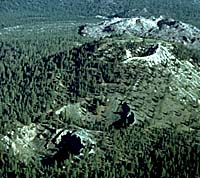Likely Eruption Sequence for the Long Valley-Mono Lake Area
If a period of unrest does lead to an eruption in the Long Valley area, its potential effects will depend critically on several factors. These include the location and number of vents, the size and style of the eruption, and the direction of the prevailing winds during the eruption. Most likely, the next eruption will be of the same style and small to moderate size of previous eruptions along the Mono-Inyo Craters chain over the past 8,000 years (note on eruption size). Based on these recent eruptions, the likely sequence of a future eruption would proceed in the following manner.
Initial Eruptions: Often Steam Explosions

Aerial view of the Inyo Craters, with
South Deadman flow in the background.
Volcanic eruptions often begin with a series of steam explosions (phreatic explosions) caused by the interaction of magma and groundwater. As magma rises toward the surface, it heats groundwater to its boiling temperature and triggers the "flashing" of water to steam. The resulting expansion and explosion of the steam can shatter rocks, hurl large blocks and volcanic ash hundreds of meters in the air, and excavate a crater in the ground.
Inyo Craters
The Inyo Craters are examples of craters excavated by phreatic explosions. They were formed by a series of steam-driven eruptions at the end of the the Inyo eruption sequence about 600 years ago.
Next: Explosive Eruption of Magma
When gas-rich rhyolitic magma (the type that has produced most of the Mono-Inyo eruptions) reaches the surface, strong violent explosive eruptions typically occur. The explosive activity blasts apart the magma into small fragments called tephra (pumice and volcanic ash), which may rise to more than 10 km (30,000 feet) above the vent. The tephra may drift tens to hundreds of kilometers downwind. With increasing distance from the vent, tephra that falls to the ground will generally become smaller in size and form a thinner layer. Modest accumulations of tephra pose no immediate threat to life or property (especially in areas where most structures are built to withstand substantial snow loads), but even a thin dusting of fine ash can seriously disrupt social and economic activities for weeks or months after an eruption.

Mount Pinatubo, Philippines
Eruption cloud - Mount Pinatubo, Philippines
A huge cloud of volcanic ash and gas rose from Mount Pinatubo on June 12, 1991, three days before this volcano's cataclysmic eruption. The eruption cloud in the image is comparable in size to the cloud that was generated by the eruption that formed the Inyo Craters and nearby lava domes in the Long Valley Caldera some 550 to 600 years ago.

Pyroclastic flow during August 7, 1980 Mount St.
Helens eruption. The view is from Johnston Ridge,
located 8 km north of Mount St. Helens.
Photograph by P. Lipman.
An explosive magmatic episode may also produce occasional pyroclastic flows. These are hot, gas-rich clouds of pumice and ash that move laterally from vents at speeds of 100 to 200 km/hour (over 100 miles/hour). Such flows pose a serious threat to life and property. Pyroclastic flows have extended up to 10 km (6 miles) in narrow, tongue-like patterns from several of the Mono-Inyo vents over the past 5,000 years. Given the likely distribution of vents, however, the chances are small that future pyroclastic flows would directly impact a local population center.
Final Eruptions: Often Lava Flows

Lava
flow, October 18, 1980
Mount St. Helens, Washington
The final stage of the recent Mono-Inyo volcanic activity typically involved the non-explosive eruption of viscous magma to form one or more mound-shaped lava domes. Evidence collected by scientists suggests that the magma erupted quietly because water dissolved in the magma was released during its upward journey instead of being trapped. For example, such lave flows include the Obsidian flow, Glass Creek flow, Wilson Butte, and the Panum Dome).

Lava flow, October 24, 1980
Mount St. Helens, Washington
Lava Flows - Mount St. Helens
Lava emerged from the vent in the crater of Mount St. Helens (top image) hours after a series of explosive eruptions generated eruption columns and pyroclastic flows October 16-18, 1980. During the next few days, the slow-moving lava spread outward to form a mound-shaped lava dome about 300 m in diameter (lower image). Photographs by T. Leighley.
Lava Fountains Also Possible in the Long Valley Area

Lava fountain
Kilauea Volcano, Hawaii
Effusive, Hawaiian type eruptions of basaltic magma have also occurred in the area and could occur again. Such eruptions typically begin with lava fountains that form small cinder cones a few hundred meters or more in diameter. These eruptions also produce hot, fluid lava flows that may extend several kilometers down-slope from the vents. The Red Cones, located 3 km south-southwest of Mammoth Mountain, were produced by eruptions of this type some 5,000 years ago. Similar flows were erupted from vents around the base of Mammoth Mountain and in the west moat of the caldera between 60,000 and 400,000 years ago. While such flows can destroy most structures in their paths, they seldom advance faster than a brisk walk and usually don't endanger people. As in Hawaii, this kind of eruption is likely to become a tourist attraction.
Lava Fountain - Kilauea, Hawaii
An effusive eruption of basaltic lava in Makaopuhi crater on Kilauea volcano, Hawaii, on March 5, 1965. The eruption broke out from a fissure several hundred yards long that cut across the west wall of the crater. View from the south rim of the crater looking down to the northwest. The main fountain is about 100 feet high, and the lava is flowing in to the bottom of the crater forming a lava lake. Photograph by D.P. Hill.
Lahars (volcanic debris and mudflows)
An eruption of either type during the winter months under heavy snow could generate debris flows that would produce locally destructive flooding in drainage systems below the eruptive vents.

